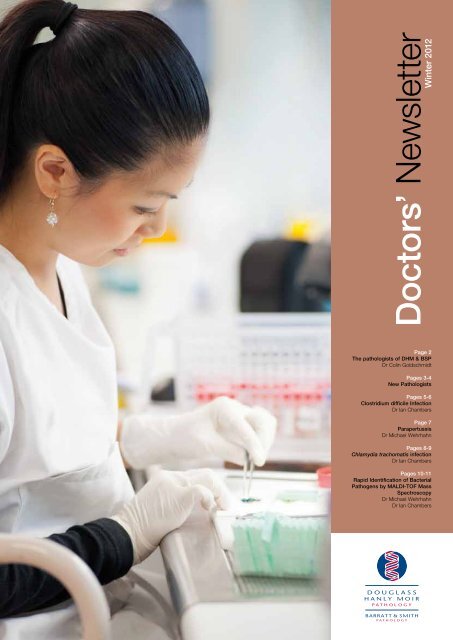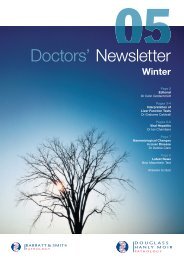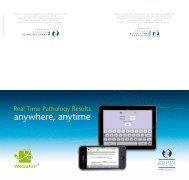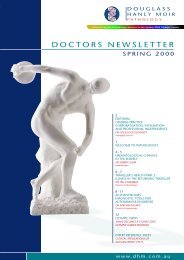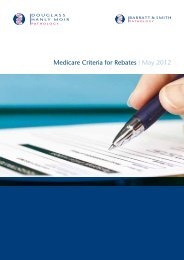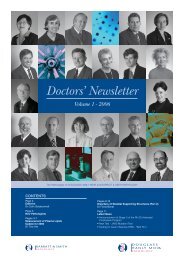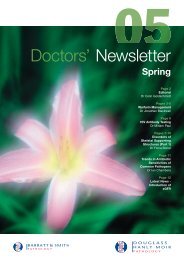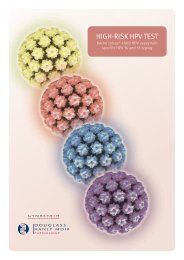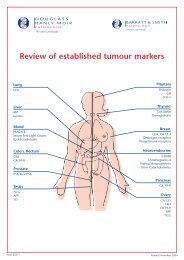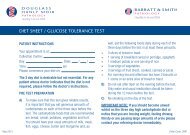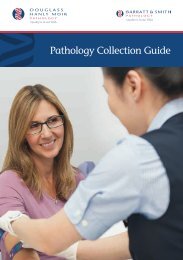Winter 2012 - Douglass Hanly Moir Pathology
Winter 2012 - Douglass Hanly Moir Pathology
Winter 2012 - Douglass Hanly Moir Pathology
- No tags were found...
Create successful ePaper yourself
Turn your PDF publications into a flip-book with our unique Google optimized e-Paper software.
The pathologists of DHM & BSPThe pathologists of <strong>Douglass</strong> <strong>Hanly</strong> <strong>Moir</strong> <strong>Pathology</strong> (DHM) andBarratt & Smith <strong>Pathology</strong> (BSP) operate at the heart of ouroperations, the laboratory. As directors and supervisors of thelab, they assure the integrity of our results by assessing andmonitoring our methods, systems, quality control, staff andequipment. They analyse results and provide interpretativecomments. And they teach.Dr Colin GoldschmidtChief Executive OfficerAs the essential link between clinicianand laboratory, our pathologistsspend much of their time in telephoneconsultation with clinicians, providingassistance with the interpretation ofresults and offering assistance in thearea of clinico-pathological correlation.They are directly involved in all labrelatedmanagement decisions and,under our commitment to ‘medicalleadership’, they play a pivotal role inshaping all decisions in the company.We remain ever-committed to operatingDHM and BSP as a Medical Practice,rather than purely as a business. In thisway, quality, service, ethical practiceand good medicine will prevail.DHM and BSP employ far morepathologists than any other pathologycompany in NSW. Over the pasttwo decades, we have developedspecialised expertise in almost allareas of laboratory testing, largely as aresult of the expertise and specialisedmakeup of our pathologist team,which has expanded in tandem withthe growth of the practice. In thisedition of the Doctors’ Newsletter, weintroduce to you a group of new DHMpathologists who have recently joinedthe practice and whom we welcomemost warmly.If you thought that all pathologists werethe same, then think again! At DHMand BSP we have haematologists,chemical pathologists, microbiologists,immunologists, genetic pathologists,histopathologists, cytopathologists,gynaecological pathologists,dermatopathologists, uropathologists,neuropathologists and others. We evenhave one pseudopathologist – that’sme, in my administrative, non-practisingrole in the practice!We encourage you to call ourpathologists at any time. When you call,you will be directed to the pathologistof your choice or to a specialistpathologist who is most appropriatefor your particular enquiry. And finally,if you wish to discuss any matter thatmatches my ‘speciality’, I shall bedelighted to take your call myself!Thank you for your support of ourpathology practice.With my warmest regards,Dr Colin GoldschmidtMB BCh, FRCPACEO<strong>Douglass</strong> <strong>Hanly</strong> <strong>Moir</strong> <strong>Pathology</strong>Barratt & Smith <strong>Pathology</strong>2
New PathologistsDR ALEXANDRA ALLENDE MB, BS, PhD, FRCPASpecialty: HistopathologySpecial interests: Ocular, gastrointestinal, urological, breast and skin pathologyDr Alex Allende is a medical graduate of the University of Sydney. Following extensive experiencein clinical medicine for several years, with particular interests in ophthalmology and research, sheundertook a Doctorate of Philosophy in the discipline of ophthalmology at the University of Sydney,with the support of an NHMRC scholarship. The thesis, incorporating histological and molecularstudies into the mechanisms of vascular development in the choroid and retina, inspired her to train inanatomical pathology, which was undertaken primarily at Westmead Hospital, with additional rotationsto Nepean Hospital and <strong>Douglass</strong> <strong>Hanly</strong> <strong>Moir</strong> <strong>Pathology</strong>. Following completion of training, whichincluded teaching, journal publications and conference presentations, she joined the histopathologydepartment at <strong>Douglass</strong> <strong>Hanly</strong> <strong>Moir</strong> and is developing her knowledge further by following interests inocular, gastrointestinal, urological, breast and skin pathology.DR JULIET BURN MB, BS, FRCPA, MIACSpecialty: HistopathologySpecial interests: Pulmonary, breast and gastrointestinal pathology, dermatopathology andcytopathologyDr Juliet Burn graduated from the University of New South Wales in 1980 and obtained herFellowship of RCPA in 1987. She joined the small independent practice, Davies Campbell de Lambert<strong>Pathology</strong>, in 1988 and became a principal in 1991. Dr Burn held Visiting Medical Officer positionsat Auburn Hospital and ICPMR Westmead, from 1988 until 2006. She has held positions on theBoard of Censors RCPA and, since 1993, she has been regularly involved in quality assurance inpathology in Australia and overseas. Dr Burn has extensive experience in teaching and supervisionof RCPA pathology registrars and in participation in multidisciplinary meetings (dermatopathology,gastrointestinal and breast pathology). She also has extensive experience in diagnostic histopathologyand cytology, with a special interest in skin, breast, lung and gastrointestinal pathology.DR ROBERT CORTIS-JONES MB, BS, FRCPASpecialty: HistopathologySpecial Interests: Dermatopathology, melanoma and inflammatory skin disordersAs an undergraduate at the University of Sydney from 1960 to 1965, when pathology was amajor component of the medical course, Dr Robert Cortis-Jones decided he wanted to become apathologist. Most of his post-graduate training in pathology was at Sydney Hospital, which was, atthat time, the location of the Melanoma Unit, making melanoma a significant professional interest forhim. He completed his pathology training in 1973 and then spent two-and-a-half years in tropicalTownsville, at the Australian Government <strong>Pathology</strong> laboratory. This further increased his interestin skin tumours, particularly melanoma. Dr Cortis-Jones moved to Wollongong as the Director ofAnatomical <strong>Pathology</strong> for the Illawarra Area Health Service from 1984 to 2000, covering almost allareas of Anatomical <strong>Pathology</strong>. Returning to Sydney, and now happy to specialise in just one area,from 2002 to 2010 he was a pathologist at Combined <strong>Pathology</strong>, Gordon. This laboratory served skincancer clinics across Australia, from Brisbane to Perth. Dr Cortis-Jones joined <strong>Douglass</strong> <strong>Hanly</strong> <strong>Moir</strong><strong>Pathology</strong> in October 2010, after Combined <strong>Pathology</strong> was bought by Sonic Healthcare. During hiscareer, he has seen major changes in the early diagnosis of melanoma, the result of collaborationbetween pathologists, both in Australia and abroad, and the great benefits of early diagnosis andtreatment Dr Cortis-Jones is now looking to increase his expertise in inflammatory skin disorders.DR SIMON CLARK MB, ChB, FRCPASpeciality: HistopathologySpecial Interests: Dermatopathology and educationDr Simon Clark graduated from the University of Otago, New Zealand. His training in pathology andhistopathology began in Wellington Hospital and was completed at Royal Melbourne Hospital. DrClark completed a Fellowship of Dermatopathology at the Skin and Cancer Foundation, Sydney.He has worked in public and private pathology and has lectured at the University of Melbourne andthe University of Queensland. Dr Clark continues to be extensively involved in general practitionereducation in skin cancer medicine. He presently runs the pathology component of the post-graduatecertificate courses in skin cancer medicine at the University of Queensland and also lectures in theMasters of Medicine course. Dr Clark joined <strong>Douglass</strong> <strong>Hanly</strong> <strong>Moir</strong> <strong>Pathology</strong> in October, 2011.3
New PathologistsDR LISA LIN MB, BS, BSc (Med), FRCPASpecialty: HistopathologySpecial interests: Breast and genitourinaryDr Lisa Lin graduated from University of New South Wales in 2004 and completed her internship andresidency training at Royal Prince Alfred Hospital, Sydney. She commenced her anatomical pathologytraining at John Hunter Hospital, Newcastle, in 2007, after which her training was predominantlybased at Westmead Hospital, Sydney. Dr Lin also gained experience working at different public andprivate laboratories through rotations to <strong>Douglass</strong> <strong>Hanly</strong> <strong>Moir</strong> <strong>Pathology</strong>, Royal North Shore andNepean Hospitals and the Department of Forensic Medicine, Glebe. During her training, Dr Lin hasbeen involved in a number of publications in peer-review journal articles, and also co-authored atextbook chapter. She has special interests in breast, genitourinary and gynaecological pathology.DR SCOTT MEAD MSc (Hons), PhD, MBChB, BHB, FRCPASpecial interest: Genetic pathologyDr Scott Mead graduated from the University of Auckland (New Zealand) where he also gained a PhDin Molecular Medicine. His pathology training was undertaken at Christchurch School of Medicine(University of Otago) and Royal Prince Alfred Hospital, Sydney. Dr Mead has a long-standing interestin cancer genetics and is currently researching the clinical application of personal cancer genomesequencing at the Kinghorn Cancer Centre (Garvan Institute). He is also involved in targeted oncologytesting at SydPath <strong>Pathology</strong> (St Vincent’s Hospital). Dr Mead is currently aConjoint Senior Lecturer atthe School of Medical Sciences, University of NSW.DR CRAIG WALLINGTON-BEDDOE BSc (Hons), MB, BS (Hons), FRACP, FRCPASpeciality: HaematologySpecial interests: Malignant haematology, flow cytometry and molecular geneticsDr Craig Wallington-Beddoe graduated with a medical degree from the University of Sydney in2001. During his early medical training, he developed an interest in haematology and undertookpostgraduate clinical and laboratory haematology training at Prince of Wales and WestmeadHospitals for the awards of FRACP and FRCPA in 2010. Dr Wallington-Beddoe is currentlycompleting his PhD studies in acute lymphoblastic leukaemia (ALL) research at the WestmeadMillennium Institute, the University of Sydney. His study is investigating the function of enzymescalled sphingosine kinases in maintaining viable ALL cells and attempting to exploit these enzymesand their associated intracellular signalling pathways to provide a novel approach to treating ALL.Dr Wallington-Beddoe joined <strong>Douglass</strong> <strong>Hanly</strong> <strong>Moir</strong>’s haematology department in November 2011.His interests are in malignant haematology, with a particular focus on leukaemias and lymphoidneoplasms, and he is familiar with a wide range of laboratory techniques and their applications toclinical haematology.DR MICHAEL WEHRHAHN BSc (Med), MB, BS (Hons), MPH (Hons), FRACP, FRCPASpecialty: MicrobiologySpecial interests: Clinical infectious diseases and diagnostic microbiologyAfter graduating from the University of NSW in 1999, Dr Michael Wehrhahn completed a Master ofPublic Health at the University of Sydney before commencing training in Clinical Microbiology andInfectious Diseases in Perth, in 2005. Experience gained at Royal Perth, Fremantle and PrincessMargaret Hospitals was complemented by appointments at Liverpool, Royal North Shore andWestmead Hospitals, where he completed his training in mid-2011.Dr Wehrhahn has developed several specific interests and areas of expertise. For the last twoyears, he has worked as a clinical mentor to HIV providers in the Highlands of Papua New Guinea,in addition to maintaining research interests in the clinical and laboratory features of communityassociatedMRSA, novel diagnostic methods for identifying fastidious bacteria and identifyingpreventable factors associated with health-care associated infections.He holds a current appointment as Adjunct Lecturer at the University of Notre Dame, Sydney.4
Clostridium difficile InfectionClostridium difficile is an anaerobic Gram-positive, spore-formingbacillus, identified first as normal bowel flora in healthy neonatesbut, over time, recognised as a potential gastrointestinal pathogen ofmajor clinical and cross-infection significance. Disease is related tothe production of two potent exotoxins: toxin A ("enterotoxin") andtoxin B ("cytotoxin"), which cause intestinal fluid secretion, mucosalinjury and inflammation.Toxin B is the essential virulence factor of C. difficile, however, beingapproximately ten times more potent than toxin A.Dr Ian ChambersMicrobiologistC. difficile is the causative organismof antibiotic-associated colitis anddiarrhoea, and is a cause of significantmorbidity (and occasional mortality)especially, but not exclusively, amonghospitalized patients. Antibioticadministration is the most widelyrecognized risk factor for C. difficileassociateddiarrhoea (CDAD) but otherrisk factors include hospitalization,advanced age, concurrent severeillness, chemotherapy etc. CDAD canalso occur without any risk factor beingidentifiable.The main clinical features ofC. difficile infection are waterydiarrhoea, abdominal pain, lowgrade fever and leucocytosis,although the clinical spectrumranges from asymptomatic carriageto severe fulminant disease andtoxic megacolon. Illness is generallyin the setting of current or recentantibiotic administration, butonset may be days or weeks afterantibiotic treatment has stopped. Theantibiotics most frequently implicatedare fluoroquinolones, clindamycin,cephalosporins, and penicillins,but virtually all antibiotics, includingmetronidazole and vancomycin, havebeen associated with CDAD.Over the last decade, hospital-acquiredC. difficile infection has become a majorproblem worldwide, with the incidenceand severity of healthcare-associateddisease increasing dramatically. Severalfactors are involved in this, includingthe high carriage rates of C. difficilein hospitalised adults (~30%) and itseasy transmissibility via fomites. A morevirulent strain of C. difficile has alsoemerged in that time. This strain(C. difficile ribotype 027) causes a moresevere illness which can be refractoryto standard therapy and is more likelyto relapse than that caused by otherstrains. Its hypervirulence may bedue to its substantially greater toxinproduction compared to conventionalstrains, and a strong correlationexists between its emergence andthe increased use of fluoroquinoloneantibiotics.5
Clostridium difficile InfectionLaboratory Tests for CDADThe two main approaches to the diagnosis of C. difficile infection are detection ofthe organism itself and detection of the toxin(s) it produces. Until recently no methodwith the necessary diagnostic sensitivity and specificity was also rapid, simple andinexpensive enough for routine use.Organism detection assays (including antigen testing and culture) have the inherentproblem that some C. difficile strains are non-toxigenic. Up to 30 percent ofhospitalized patients are colonized by C. difficile without having disease and thereforethe presence of the organism by itself does not prove pathogenicity.Enzyme immunoassay (EIA) for either toxins A and B combined or toxin B aloneis the method in widest use. While specificity is generally good and false-positivesuncommon, the diagnostic sensitivity of these assays is only moderate and the falsenegativerate is unacceptably high. EIA should not be used for the investigation ofpossible CDAD.Polymerase Chain Reaction (PCR) provides greatly enhanced diagnostic sensitivity for CDAD. The tcdB gene of C. difficile(which encodes toxin B) is considered to be its primary virulence factor and is present in virtually all diarrhoeagenic strains,including the hypervirulent O27 ribotype. Detection of the tcdB gene by PCR provides rapid and accurate diagnosis, which inturn allows prompt implementation of treatment and infection control measures. PCR overcomes the disadvantages inherent inother methods and has recently been introduced at <strong>Douglass</strong> <strong>Hanly</strong> <strong>Moir</strong> <strong>Pathology</strong> for the diagnosis of CDAD.Several aspects of this assay should be emphasised1 CDAD is associated with current or recent antibiotic administrationand/or recent hospitalisation and testing for C. difficile is appropriatewhen such risk factors are present in an individual with diarrhoea. Itis not a common cause of sporadic, community-acquired diarrhoealillness in otherwise healthy individuals and testing for it should not beincluded in the initial laboratory investigations of such patients.2 The tcdB PCR test is appropriate for use only on unformed stoolfrom patients with clinically significant diarrhoea. Certain patientgroups (eg current or recent hospital inpatients and infants in the firstyear of life) have high rates of asymptomatic carriage of toxigenicC. difficile and such individuals do not require treatment.Formed stool should only be tested in exceptional circumstances.3 The high diagnostic sensitivity of the tcdB PCR provides reliable,single-sample diagnosis of CDAD. If an initial result is negative thediagnostic yield is not significantly increased by testing anotherspecimen.4 Nucleic acid remains detectable for several weeks after effectivetreatment for CDAD, making test-of-cure unnecessary and possiblymisleading. An exception to this is in the context of relapsing illness.5 If possible, specimens should be refrigerated until transportedto the laboratory. Specimens are stable for up to 2 days at roomtemperature and 5 days if refrigerated at 4˚C.6 Faecal specimens may occasionally contain factors which inhibit thePCR process. If such inhibition is found and cannot be resolved,repeat collection should be considered.PCR represents a major advance in the diagnosis of C.difficile-associated disease. <strong>Douglass</strong> <strong>Hanly</strong> <strong>Moir</strong> <strong>Pathology</strong>is pleased to be able to provide this test as the primary investigation for this condition.For further information, or to discuss a patient please contact Dr Ian Chambers or Dr Miriam Paul on 98 555 3126
ParapertussisBordetella parapertussis, like B. pertussis, is a recognised cause ofwhooping cough in all ages and, in some countries, causes up toone-third of whooping cough cases.Dr Michael WehrhahnMicrobiologistThe clinical presentation is similar tothat of B. pertussis but is generallymilder, with the majority of patientshaving a cough lasting less than a weekand entire illness that resolves withina month. The “whoop” is a feature inup to 60% of cases and post-tussivevomiting in up to 40% of cases.The reduced severity of parapertussisinfection is thought to be related to alack of key virulence factors, such aspertussis toxin (PT), that are found in B.pertussis. There is no cross immunitybetween pertussis and parapertussisand, as the components in the currentpertussis vaccine target toxins likePT, the vaccine has limited, if any,protection against parapertussis.In those with severe disease causedby B. parapertussis, one can expectclinical improvement from the sameantibiotics recommended for thetreatment of B. pertussis. Integrated Cycler fordetection of B. pertussis andB. parapertussis Child with whooping coughNo data is available with regard tothe value of prophylaxis for highriskcontacts of patients with B.parapertussis and it is not a notifiabledisease, in contrast to B. pertussis.While culture, in the past, has beenthe main way of differentiating thesetwo species, few laboratories inAustralia still culture for B. pertussis/parapertussis. At DHM, the recentintroduction of a real-time multiplexPCR that detects B. pertussis andB. parapertussis simultaneously hasallowed the diagnosis of an additionalproportion of whooping cough cases.This test is performed Monday to Fridaywith a result expected within 24 hours.Diagnosis of parapertussis may preventunnecessary further investigation of apatient’s cough illness and support thedecision to treat with antibiotics.For further information, or to discuss a patient please contactDr Michael Wehrhahn on 98 555 2877
Chlamydia trachomatis infectionChlamydia trachomatis is the most commonly notified sexuallytransmissible bacterial disease in Australia, with annual casenotificationsdoubling since the early 1990s. It affects both genders,with approximately 75% of reported infections occurring in thoseaged less than 30 years. It is also the most common infectivecause of pelvic inflammatory disease and subsequent female-factorinfertility in Australian women. Several countries have institutedscreening programs in asymptomatic young women to prevent suchlong-term complications of this infection. Risk factors for chlamydiainfection include multiple sexual partners, a recent change in sexualpartner and non-use of barrier contraceptives, such as condoms.Endocervical C. trachomatis infection has also been associated withan increased risk of acquiring HIV infection and may also increaseHIV infectiousness.Dr Ian ChambersMicrobiologistMode of transmissionThis is predominantly by sexualcontact, but occasionally from motherto baby during vaginal delivery. Thehigh proportion of asymptomatic casesresults in untreated infection, ongoingtransmission and increased incidenceof long-term sequelae.Diagnosis of genitourinaryC. trachomatis infectionRACGP guidelines recommend annualtesting for all sexually active 15-25year-olds, including those who areasymptomatic. Screening for chlamydiacan be opportunistic, that is, when thepatient presents for unrelated reasons.Polymerase Chain Reaction (or oneof the other nucleic acid detectionmethods available) is the test of choicefor diagnosing C. trachomatis and avariety of specimens can be suitable.The preferred specimen for Chlamydiatesting in men is urine, rather than aurethral swab. A properly collectedmale urethral swab causes discomfort,which means that most male urethralswabs are not properly collected andgive inferior results, compared to urine.The requirements for a first-void urine,as opposed to a mid-stream, and thatan hour should have elapsed sincelast passing urine, have become morerelaxed over time because of the veryhigh sensitivity of the methods currentlyused for diagnosis.Urine is collected in the usualyellow-top urine jar. Urine is alsoan acceptable specimen for routinechlamydia testing in women, althoughif a speculum examination is beingconducted, then a swab taken from theendocervix is recommended.Testing for chlamydia in women canalso be performed on a low vaginalswab. This does not require the useof a speculum and the swab can beself-collected by patients if they wishto do so.A dry swab (ie, a swab for whichthe transport tube contains noliquid medium) is recommended forchlamydia PCR. If available, a ‘flocked’swab is better than a standard swabbecause it collects more material.Flocked swabs are available from theStores department.If a ThinPrep liquid cytology vial hasbeen collected, this specimen is alsosuitable for use in the C. trachomatisand N. gonorrhoeae PCR tests.Despite advice to the contrary fromsome professional groups, the growingincidence of gonorrhoea suggeststhat this diagnosis should also beconsidered when testing for C.trachomatis is undertaken. The samespecimen can be used for both tests.Re-testing for C. trachomatisTest-of-cure is not usuallyrecommended after treatment, exceptwhen the patient is pregnant or unlessthere is persistence of symptoms.Repeat testing is indicated, however, ifthere is a continuing risk of re-infection.Serology for C. trachomatisThe diagnosis of genital chlamydiainfection cannot be confirmed orexcluded serologically. Serology hasno useful role in this situation: it is notaccurate and should not be done.Chlamydia trachomatis PCR isperformed daily, using the Roche cobas4800 instrument.8
Rapid Identification of Bacterial Pathogens byMALDI-TOF Mass SpectroscopyNot many deliveries to <strong>Douglass</strong> <strong>Hanly</strong> <strong>Moir</strong> <strong>Pathology</strong> of large,shiny machines encased in bubble-wrap are addressed to theMicrobiology Laboratory, but that day has come at last.<strong>Douglass</strong> <strong>Hanly</strong> <strong>Moir</strong> <strong>Pathology</strong> is the first private laboratory inAustralia to begin using an instrument that is amongst the mostsophisticated available for the rapid and reliable identificationof bacterial and fungal pathogens. MALDI-TOF (Matrix-AssistedLaser Desorption Ionisation – Time of Flight) technology uses massspectroscopy (MS) to analyse bacterial and fungal cultures. This notonly allows much faster identification of potential pathogens, butprovides greater certainty of that identification.Dr Ian ChambersMicrobiologistMALDI-TOF-MS relies on thepremise that virtually every bacterialspecies, when analysed using massspectroscopy, has a unique “proteinsignature”, based on mass-chargeratio. Microbial identification is achievedby comparing the mass spectralprofile of the test organism with adatabase consisting of more than 500medically important bacteria and 70relevant fungi. If the required level ofconcordance is reached between testand reference profiles, identification hasbeen achieved.Routine use of this technology, overthe last decade in Europe and morerecently worldwide, has established itsclinical utility. More rapid identification ofpathogens (taking minutes rather thanthe 4-24 hours required by traditionalidentification methods) has translatedinto improved clinical outcomes.Dr Michael WehrhahnMicrobiologist10
Rapid Identification of Bacterial Pathogens byMALDI-TOF Mass Spectroscopy Vitek MS: Faster identification of pathogensand improved management of sepsis.On average, it is anticipated that the identification and reportingof most organisms will take a day less than is currentlypossible. While formal antibiotic susceptibility testing is stillrequired, rapid pathogen identification allows empiric antibioticselection to be made with greater confidence and appropriateantibiotic selection leads to improved clinical outcomes.This is of greatest importance in critical conditions, such asbacteraemia and sterile-site infections, but treatment andoutcomes of less critical conditions, such as soft-tissue andurinary tract infection, will also be improved.MALDI-TOF-MS will also shorten the time it takes to reportuncommon and difficult-to-identify organisms which arecurrently sent to reference laboratories. In many cases, thiswill shorten the identification-time from a week or more to thesame day the culture becomes positive.The introduction of MALDI-TOF-MS technology represents afundamental shift in the approach to diagnostic microbiology.In an area of pathology where oxgall, rabbit plasma and fetalbovine serum are still essential reagents for the identification ofbacteria and fungi, a shiny new machine is a welcome addition.For further information, or to discuss a patient please contactDr Ian Chambers on 98 555 330 or Dr Michael Wehrhahn on 98 555 28711
DOUGLASS HANLY MOIR PATHOLOGY PTY LIMITED • ABN 80 003 332 858A subsidiary of SONIC HEALTHCARE LIMITED • APA ABN 24 004 196 90914 GIFFNOCK AVENUE • MACQUARIE PARK • NSW 2113 • AUSTRALIATEL (02) 98 555 222 • FAX (02) 9878 5077MAIL ADDRESS • LOCKED BAG 145 • NORTH RYDE • NSW 1670 • AUSTRALIABARRATT & SMITH PATHOLOGYA trading name of DOUGLASS HANLY MOIR PATHOLOGY PTY LIMITED • ABN 80 003 332 858A subsidiary of SONIC HEALTHCARE LIMITED • APA ABN 24 004 19631 LAWSON STREET • PENRITH • NSW 2750 • AUSTRALIATEL (02) 4734 6500 • FAX (02) 4732 2503MAIL ADDRESS • PO BOX 443 • PENRITH • NSW 2751 • AUSTRALIACo-brand-DNL-<strong>Winter</strong><strong>2012</strong>-9737


